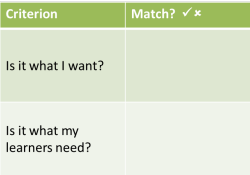TKT Core Module 2: Lesson planning and use of
resources for language teaching
Selection and use of coursebook materials, supplementary materials
and activities and teaching aids

The principles of evaluating and choosing materials are the same,
whether you are choosing a coursebook, a set of supplemental
materials or anything else.
This is quite a long guide so you may like to follow it in parts.
 |
Key concepts in this guideBy the end of this guide, you should be able to understand and use these key concepts: |
Look out for these words like this
in the text.
There will be tests at the end of the guide for you to check that
you understand the ideas.
  |
Two ways to evaluate |
- Retrospectively,
by looking at the material to see how well it served its purposes and how the learners and teachers felt about it. You are probably deciding whether to use it again. There are three ways to do this:- Ask the students how they felt. Whether materials pleased and engaged the learners is important. However, unless the next set of learners are very similar, it is not at all certain that what pleased one group will please the next group.
- Ask the teacher(s). This is more reliable, especially if the teachers are going to teach the same course again.
- Test the outcomes. This can be helpful but it is very difficult to know if success or failure is due to the choice of materials (rather than the learners' motivation, the teachers' skills etc.).
- Prospectively,
By assessing how well the material will perform in meeting course objectives. To do this, we need to ask some good questions and get some clear answers.
 |
Asking the right questions |
Prospective evaluation is what most people understand by materials evaluation.
It is the effort to decide whether whatever material you are
presented with is fit for its purpose.
In simple terms: will it work?
We can do two other things before we ask our own questions:
- Read a review
Reviews of new, and not so new, materials appear in the professional press quite frequently. We can decide on the basis of good reviews and reject on a similar basis.- Problem 1: reviewers may not be using the same criteria that you are. What's important to the reviewer may not be important to you and your learners.
- Problem 2: a reviewer is not looking at the materials with any particular course or group in mind. What may be usable with a group of adults on a short course will not work with a group of children over a school year.
- Rely on the
publishers' descriptions
Read the information on the back cover and the descriptions provided by the publishers to decide whether the material will suit your purposes.- Problem 1: for financial reasons, coursebooks have to be
designed to appeal to as wide a range of markets as
possible. This often means that they become a mixture of
different approaches and try to cover the syllabus of as
many settings and nations as possible.
Much of what is included may simply not be relevant to you and your learners. - Problem 2: publishers vary widely in what they feel are key characteristics of course materials. They also vary in their use of terms like 'intermediate' and 'intensive'. It may, therefore, be just impossible to make useful comparisons or judgements based on what they tell you.
- Problem 1: for financial reasons, coursebooks have to be
designed to appeal to as wide a range of markets as
possible. This often means that they become a mixture of
different approaches and try to cover the syllabus of as
many settings and nations as possible.
Teachers have to rely on their own judgements and look at the material carefully. Too often, however, this becomes something like:
It looks nice and is at the right level, so I'll use it.
We need to have some clearer questions to ask and go beyond Is it pretty and at the right level?
 |
Check lists for evaluation |
Some check-lists run to over 50 questions and are very difficult
to apply. Here we will try to identify the really important
questions but remember that everyone is in a unique setting so you
will have to subtract from or add to the list (or both).
Some of these questions will only apply to selecting coursebooks.
- Availability
- Can you get hold of it?
Can you get more of it?
Are all the components (recorded material, websites, teacher's guide etc.) available now? - Layout/graphics
- Is it pretty and appealing or dense and dull? Younger learners in particular will not respond well to boring or monochrome materials.
- Accessibility
- Can you and the learners find your way around?
Is there a useful contents page telling you what is in each unit or section?
Is there advice for the learners?
Is self-study directed?
Is it clear what progress is being made? - Selection/grading
- Is the material at the right level?
- Is the learning curve and level of challenge to steep, too
shallow, too low or too high for your learners?
Does it cover the material your learners need? (I.e., is it compatible with your syllabus and objectives?) - Appropriacy and cultural bias
- Will the content appeal to your learners?
Is it potentially offensive?
Does it cater for your learners' culture(s)? - Authenticity
- Are the texts and the language authentic (or nearly so)?
- Are the task and activities authentic? Will your learners want to do them?
- Guidance
- Is the teacher's book any good or does it just tell people
the right answers and suggest going on to Activity 5 when you
have finished Activity 4?
Does the teacher's book cater for inexperienced teachers by setting out how to approach the units and the lessons?
 |
CATALYSTAn alternative (and briefer) way to evaluate material is
to use a mnemonic (Grant, 1987). |
Again, not all these categories will have the same relevance or importance in all settings.
 |
Keep it simple |
There is much to be said for keeping things simple.
Here's the ELT
Concourse materials evaluation machine. It is a way
of looking at materials which will also allow you to have the time
to use them.

If you are getting tired, this is a good place to stop and have a break.
 |
Adapting materials |
No materials are perfectly adapted for your learners
so we have to be able to adapt them and make them fit for our
learners.
We do this in response to what we see as a problem.
 |
Task 1:
Think about these problems and how you would adapt the
materials to overcome them |
| Problem | Adaptive solution |
|
The material is too short with not
enough practice |
Two possible ways forward:
Write more practice items in the same format. Find more materials that will follow on from what you are doing but cover the same target. |
| The text
is too long |
Alternatives:
Cut it if you can but be careful not to cut out anything the learners need to do the tasks or understand key points. Divide the text and give different parts to different groups so they can cooperate later in doing the task |
| The
material is too easy |
Alternatives:
Re-write parts of the text to make it more difficult. Cut up a text so that the learners have to order it and then read for information. Ask harder questions (grading the task), for example, ones which get the learners to think about the author's intentions (reading between the lines). |
| The
material is too predictable |
Alternatives:
Take things in a different order. Pre-teach lexis rather than focusing on it in the texts. Alter the text to make it personal to your students (changing names, ages etc.). |
| The
material is useful but dull |
Alternatives:
Find graphics / TV clips etc. that focus on the same topic. Get the learners to illustrate the text with drawings and ideas. Explain its usefulness and get the learners to ignore its dullness (older learners, in particular, can respond well to this). |
| The
material is useful but it doesn't focus enough on form.
It expects the learners to know the language forms already |
Alternatives:
Make sure you insert your own focus on form at the appropriate time. This may mean you have a short presentation and controlled practice phase before you even open the book. Get the learners work together to see if they can extract the rules of the grammar from the examples in the materials. |
| The
material is good for formal language work but there isn't
enough skills practice, especially of speaking and listening |
Alternatives:
Find recordings / TV clips etc. that focus on the same topic. Design a speaking activity to use at the end of each unit which gets the learners to apply the language / skill they have learned in oral practice. Introduce each unit's topic by using live listening to you discussing a personal aspect of the topic of the unit. For example, if it's about holidays, tell the learners to listen to a holiday experience that you had and to write down the two good and two bad things that happened to you. |
 |
Supplementary materials |
types of supplementary materials

- Web-based
- There was a time when anyone working outside an English-speaking
setting had a hard time finding extra materials with which to
supplement the diet of a coursebook. No longer.
If you are reading this, you are connected to the web and there you will find billions (really) of pieces of material you can bring into your classroom to brighten up the day and provide much-needed practice. Of the estimated 500,000,000 websites out here, over half are in English. (The next three biggest languages have 15% between them.) - Printed
- Additionally, there are the 'traditional', text-based supplementary materials such as books focused on particular skills, communication games and so on as well as printed media in English (mostly newspapers and magazines).
- TV and radio
- Media globalisation has meant that a good range of English-language TV and radio programmes are available to anyone who has an internet or satellite connection. If you also have the ability to record and play back to the class, you have a powerful and rich resource base to draw on.
- People
- Around 375 million people speak English as a first language
and the same number use it as a second language (at work etc.).
In addition, 750 million people use English as a foreign
language.
English is an official or widely used language in 60 countries.
Even if you are not teaching in an English-speaking environment, therefore, it is usually not too difficult to find expert users of English who are willing to come into your classroom, or to whom your students can go, to provide supplementary communication practice.
It would be strange not to take advantage of them.
Why use supplementary material?

There are a number of good reasons:
- Because the class needs more.
Most people can read an entire coursebook in an hour or so, cover to cover. Coursebooks are not usually very rich sources of language. If you accept that one of the most powerful aids to learning is repeated and continual exposure to examples of language in use, then we need to supply a much richer environment than any coursebook can hope to give us. - Because people get bored.
We can simply work through a coursebook from Unit 1 to the end but this means- that you think all the units and topics are relevant
- that the class is very tolerant
- that the same approach will be followed in every lesson (because coursebook writers usually have a clear idea of what they understand as 'best practice')
the dangers of supplementary
materials

Be careful. Taking texts, songs, supplementary materials, video clips, magazines and newspapers etc. into your classroom can certainly add variety and give your learners exposure to authentic English but:
- Many materials are intended for native-speaker users of the language and may be over the heads of your learners (and you). You may think they are useful but if nobody can understand them the lesson will be boring and demotivating.
- The one-off lesson syndrome. Something may be attractive, interesting and at the right level but if it is not relevant to your learners needs and isn't integrated into the syllabus, your learners may not be getting a balanced diet.
- Too many supplementary materials may require lots of careful planning and preparation. Do you have the time for that?
 |
Teaching aids |
 |
 |
 |
 |
 |
 |
Task 2:
There are four kinds of aids in the pictures: boards,
projectors, books and phones. Can you think of one
more? Make a few notes and then click here. |
- Recording and playback equipment: video and audio
- Realia
 |
 |
Task 3
Think now about how you might use these aids
and make a few notes. Then click here. |
boards
Boards are the central and most versatile aid of all. They
don't have to be interactive (although that helps) and they don't
need to be colourful (although that helps, too) but they do have to
be organised.
The board is often the focus of all or part of every lesson.
It is where the learners look for critical information and it is often from
the board that they note things down to take away. If you
write something on a board, most learners will assume that what you
write is important.
That means:
| Don't | Do |
| Use the board
as a kind of notepad. It will soon fill up with all kinds of irrelevance. |
Use the board
to emphasise important things Clean off small items which have simply come up in the lesson and aren't central. |
| Write too quickly or small. | Write clearly –
print if need be. In many cultures, poor handwriting is seen as evidence of poor education. |
| Be random. | Organise things
by position and colour. Your learners will get used to knowing where and what colour to look for models, new words, instructions and so on and will also assume that what is on the board is important. |
| Monopolise the board. | Allow your learners to use the board to give feedback. |
| Stand between the board and your class. | Make sure the board and everything on it is visible from every seat. |
data projectors
These won't be available everywhere but where they are, they can be very useful. Use them for:
smart phones
These are underused but many students have them. Their main advantage in the classroom is that they can be used to record students talking and to take quick images. You need to consider carefully how that is done and how you will listen to / see the results.
audio and video equipment
There are two different ways to use these:
- As input materials:
Language teachers have long used these aids and, with DVD and CD players, they have become easier to use. The trick is to be fully acquainted with the equipment so you don't waste time playing with the controls and trying to find the bit on the CD you want to play. Practise.
Beware, too, of overly long sequences. The maximum is around 5 minutes before audio recordings start to wash over people or video recordings become just passively watching TV. At lower levels, one minute is probably the limit.
You need to set the learners clear tasks to achieve before they listen or watch, while they are listening or watching and after they have listened and watched. Make sure there is a purpose to it.
These are aids, not substitutes for the teacher. - To record learners' output:
This use needs a bit more care and expertise to set up but it can be very rewarding to hear oneself speaking a foreign language accurately and comprehensibly. On the other hand, it can be acutely embarrassing to hear oneself speaking it poorly and incomprehensibly.
Handle with care.
realia
Bringing real objects into the classroom can be engaging and motivating (especially if the learners have brought them). Consider, for example,
- Real texts:
a letter / email from a friend or relative of yours or one of the learners is immediately more intriguing than something made up in a coursebook. - Objects:
if your aim is to teach vocabulary for things like fruit, stationery, colours, clothes etc. then having real objects to talk about and describe is motivating and memorable. The same applies to lots of adjective teaching, of course. - Notices, adverts and mini-texts:
many institutions have places for people to post notices. Exploit them. - Newspapers, brochures and magazines:
can form the basis for a huge range of lessons (not just those focused on reading skills). Get your learners to gather them, if possible. Be careful to remember that newspapers contain a large range of different text types and each one requires a different set of skills to access it. - Most of us carry 15 or so items with us at
all times.
In a class of ten, you have a potential 150 objects to talk about and describe. Ask people to take one object from their pocket, handbag, rucksack etc. and explain to a partner or the class what it is and why it's important. - Personal things:
a useful set of lessons can be built around the learners bringing to class a small object that is, in some way, significant for them and explaining to others what it is, how they acquired it and why it's significant.
 |
Self-test questions |
Before you go on, make sure you can answer these questions. If you can't, go back to the sections which give you trouble.
If you are happy with your progress, go on.
 |
Tests and practice for TKT |
This is quite a long guide so there are tests for each part.
| Test 1 | A matching task to do with selecting coursebooks |
| Test 2 | A matching task on adapting materials |
| Test 3 | A quiz: choose the WRONG answer! |
This is the end of the Module 2 course. Thank you for doing
the course!
If you have now followed all the guides to Module 2 of the TKT, you
can:
Revise Module
2 by doing all the tests in the course.
Try a full practice examination for Module 2.
Return to the Module 2 index:
![]()
Return to the TKT Course index
Reference:
Grant, N, 1987, Making the most of your textbook, Harlow:
Longman
